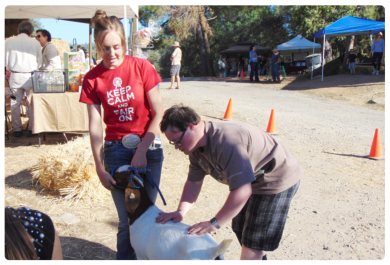4-H Thrive

4-H Thrive is our Approach to Positive Youth Development
Thriving is “a forward, purposeful motion towards achieving one’s full potential.”
In our view, thriving is based on achieving the optimum rather than on the avoidance of negative outcomes. And, at its core, the relationship between caring adults and young people are critical to youth realizing their full potential, or thriving.
The principles of thriving are woven throughout all aspects of the California 4-H Youth Development Program. Our approach offers young people both the support and opportunities necessary to reach their full potential.
Thrive Educational Series
This curricula works great as a stand-alone leadership project or as a mentoring tool for county ambassador or all-star programs. The curricula offers series for all age levels including primary members!
Go to the Thrive Educational Series Resources
Youth development practices that promote thriving
- Safety – young people feel physically, emotionally, and culturally safe
- Relationship Building – young people experience emotional and practical support from adults and peers, experience guidance from adults, and build knowledge of adults and peers
- Youth Engagement – youth are in positions of reponsibilty and leadership, are engaged in meaningful decision making, and develop a sense of belonging or ownership
- Community Involvement- youth build knowledge of their community beyond the program, have opportunities to give back to their community, and experience a sense of connection to a larger community
- Skill Building- youth are motivated to learn because activities interest them, have a chance to stretch their skills and abilities, and internalize a sense of mastery or competence
For more information about Positive Youth Development click here.
Theory Behind the Practice
In 4-H we build communities by intentionally creating environments which research has proven to be both positive and successful in developing youth into healthy, thriving young adults. Thriving focuses on building core youth development practices (from our framework) in all areas of 4-H. This is best done through developing staff and adult volunteers’ knowledge and skills in the principals of thriving.
4-H Thrive is a skill building and personal development project
4-H offers opportunities for youth to realize their full potential through a series of age appropriate educational materials. The series builds skills in 4-H members by:
Identifying and nurturing their Spark

Sparks are what help youth see the potential within themselves. Sparking the inner passions, interests and talents of young people that inspire them on the path to thriving is central to youth development work.
Volunteers partner with youth in the discovery process by encouraging young people to participate in and take on leadership roles through 4-H’s learning-by-doing approach to program delivery. Sparking the passions and interests of youth goes beyond project and club program involvement.
Learning and practicing goal management skills

In 4-H, adults facilitate the process of empowering youth to practice goal management skills. Establishing goal management habits creates communities of people who thrive and succeed throughout their lives.
Young people in 4-H have extensive opportunities to plan, organize and coordinate projects, activities and events. The growth gained through these opportunities is part of a larger effort to ensure that youth are intentionally moved toward a trajectory of thriving.
Youth learn goal management skills by:
- acquiring knowledge that goal setting involves a conscious shift in behavior.
- selecting goals that are meaningful, realistic and that will require stretching their skills and abilities.
- creating strategies for pursuing their goals.
- changing the strategies or goals when the original goal is unattainable.
Developing a growth mindset

In 4-H youth and adults partner together to develop a mindset of success. This growth mindset is defined by the ability to rise to the challenges of life. Current brain research tells us that through practice and effort both youth and adults increase their potential to learn and develop across the lifespan.
Volunteers are central to the process of helping youth to recognize the opportunities within 4-H to learn and grow from successes as well as setbacks. When youth might be otherwise tempted to limit themselves based on past failures, a growth mindset encourages youth to view their potential capabilities as limitless.
Developing youth self-reflection skills.

The concept of self-reflection is at the core of the 4-H club program delivery model. Guiding youth toward reflecting on self is inherent in 4-H Record Books, club based activities and youth leadership development components of programming, but the largest opportunity for growth through self-reflection is within the context of a strong youth-adult partnership.
Adults facilitate dialogue in the project setting around the "Six C’s" of youth development defined by the research of Dr. Richard Lerner at Tuft University’s Institute for Applied Research in Youth Development.
The Six C's The six C's theory of positive youth development identifies six important characteristics that help young people grow into thriving and successful adults. Research has demonstrated that youth who have higher levels of these Cs tend to have more positive behaviors and developmental outcomes compared with youth who have lower levels.




